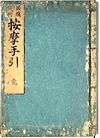Anma
Anma (Japanese: 按摩) refers to both a practice of traditional Japanese massage and to practitioners of that art. Modern shiatsu is largely derived from anma.

History
Anma is thought to be of Chinese origin, developing from Tui Na. Tui Na techniques arrived in Japan during the Nara period (710–793 CE), along with other techniques of traditional Chinese medicine, and were practiced in government-sponsored hospitals. Anma as a unique system was founded in 1320 by Akashi Kan Ichi.[1][2]

Anma was popularised in the seventeenth century by acupuncturist Sugiyama Waichi, and around the same time the first books on the subject, including Fujibayashi Ryohaku's Anma Tebiki ("Manual of Anma"), appeared.[3] The Fujibayashi school is the foundation of modern anma.[4] Anma (masseurs) were often nomadic, earning their keep in mobile massage capacities, and paying commissions to their referrers. In the nineteenth century, the image of anma suffered somewhat from an association with the ukiyo lifestyle of urban Japan, and it was subsequently less well-regarded as a therapy.[5]
During the Meiji period, the appearance of Western medicine reduced anma's prominence still further. Many of its techniques were subsumed into shiatsu and Western massage practices, although research into anma for medical purposes continues at Tokyo Kyoiku University.[3] Anma is still practiced independently of shiatsu in Japan, with practitioners being certified by the health board of their local prefecture.[6]
Blind practitioners
Since Sugiyama's time, anma has been strongly associated with the blind.[7] Sugiyama, blind himself, established a number of medical schools for the blind which taught this practice. During the Tokugawa period, edicts were passed which made the practice of anma solely the preserve of the blind – sighted people were prohibited from practicing the art.[1] As a result, the "blind anma" has become a popular trope in Japanese culture.[8] This has continued into the modern era, with a large proportion of the Japanese blind community continuing to work in the profession.[9]
During the occupation of Japan by the Allies after World War II, the practice of anma was banned (along with other aspects of traditional Japanese culture) by General MacArthur. The ban prevented a large proportion of Japan's blind community from earning a living. Writer and advocate for blind rights Helen Keller, on being made aware of the prohibition, interceded with the United States government; at her urging, the ban was rescinded.[10]
In recent years the fictional character of Zatoichi, the blind swordsman, has brought the concept of the "blind anma" into the public eye in the West.[11] Blind anma are also commonly used to comedic effect in Japanese cinema.
Techniques
Anma practices uses common massage techniques such as kneading, rubbing, tapping and shaking. These activities are directed at specific vital points and meridians on the body.[3] The seven traditional techniques are: pressing/stroking, grasping/kneading, strengthening, compressing, vibrating, tapping and "hand music". In addition, methods of abdominal palpitation (按腹 ampuku), developed by Shinsai Ota in the seventeenth century, are used.[12][13] It is considered quite a vigorous form of massage, with gripping movements intended to increase blood flow to the muscles and deep tissues, and forceful acupressure techniques applied with the knuckles. The treatment is usually performed through the clothing, rather than directly on the skin.[14]
References
- Jōya, Moku (1985). Mock Jōya's Things Japanese. The Japan Times. p. 55.
- Fu ren da xue (Beijing, China). Ren lei xue bo wu guan; S.V.D. Research Institute; Society of the Divine Word (1962). Folklore studies. p. 235.
- Kaneko, Dr. DoAnn T. (2006). Shiatsu Anma Therapy. HMAUCHI. ISBN 9780977212804.
- Louis Frédéric (2002). Japan Encyclopedia. Harvard University Press. pp. 28–29. ISBN 978-0-674-01753-5.
- Micozzi, Marc S. (2001). Fundamentals of complementary and alternative medicine. Churchill Livingstone. p. 120. ISBN 9780443065767.
- Liza Crihfield Dalby (1984). All-Japan: the catalogue of everything Japanese. Morrow. p. 132. ISBN 978-0-688-02530-4. Retrieved 11 May 2012.
- Young, Jacqueline (2007). Complementary Medicine For Dummies. John Wiley & Sons. p. 99. ISBN 9780470519684.
- Beresford-Cooke, Carola (2010). Shiatsu Theory and Practice. Elsevier Health Sciences. ISBN 9780080982472.
- American Foundation for the Blind (1973). "The New outlook for the blind". 67: 178. Cite journal requires
|journal=(help) - Beresford-Cooke, Carola (2003). Shiatsu Theory and Practice: A Comprehensive Text for the Student and Professional. Elsevier Health Sciences. p. 2. ISBN 9780443070594.
- David West (26 December 2006). Chasing Dragons: An Introduction to the Martial Arts Film. I.B.Tauris. pp. 33–. ISBN 978-1-85043-982-0. Retrieved 11 May 2012.
- Kiiko Matsumoto; Stephen Birch (1988). Hara Diagnosis: Reflections on the Sea. Paradigm Publications. p. 315. ISBN 978-0-912111-13-1.
- Carl Dubitsky (1997). Bodywork Shiatsu: Bringing the Art of Finger Pressure to the Massage Table. Inner Traditions * Bear & Company. p. 7. ISBN 978-0-89281-526-5.
- Jacqueline Young (2007). Complementary Medicine For Dummies. John Wiley & Sons. p. 99. ISBN 978-0-470-51968-4.